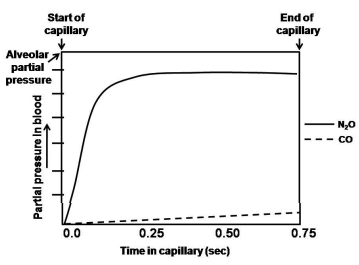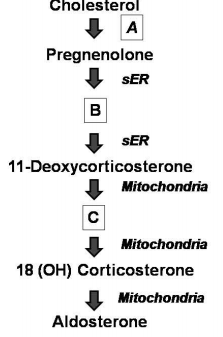 Multiple Choice Questions
Multiple Choice QuestionsDifferent leads are used to record ECG of humans. Which one of the following is NOT unipolar leads?
Augmented limb leads
V1 and V2 leads
Standard limb leads
VR and VL leads
If in a blood transfusion, type A donor blood is given to a recipient having type B blood, the red blood cells (RBCs) of donor blood would agglutinate but the recipient's RBCs would be least affected. These observations can be explained in the following statements:
A. Agglutinins in the recipient's plasma caused agglutination by binding with type A agglutinogens.
B. The agglutinins of donor blood were diluted in the recipient's plasma resulting in low agglutination.
C. Low tire of anti-A agglutinins is the cause of low agglutination of the recipient's RBCs.
D. High agglutination of donor RBCs is the outcome of high titre of anti-B agglutinins.
Which of the above statement(s) is/ are incorrect?
Only A
A and B
Only B
C and D
The arterial pressure usually rises and falls 4 to 6 mm Hg in a wave-like manner causing "respiratory waves". The probable mechanism of these waves has been proposed in the following statements:
A. The more negative intrathoracic pressure during inspiration reduces the quantity of blood returning to the left side of the heart causing decreased cardiac output.
B. The changes of intrathoracic pressure during respiration can excite vascular and atrial stretch receptors which affect heart and blood vessels.
C. The activity of medullary respiratory centres can influence the vasomotor centre.
D. The "respiratory waves" are the outcome of the oscillation of the central nervous system ischemic pressure control mechanism.
Which of the above statement(s) is/are not appropriate?
Only A
A and B
B and C
Only D
External pressure given on a mixed nerve causes loss of touch sensation while pain sensation remains relatively intact. On the other hand application of local anaesthetics on the same nerve, induces loss of pain sensation keeping touch sensation least affected. These observations can be explained by the following statements:
A. External pressure causes loss of conduction of impulses in small diameter sensory nerve fibres.
B. Local anaesthetics depress the conduction of impulses in large diameter sensory nerve fibres.
C. Touch-induced impulses are carried by fibre type A.
D. Fibre type C is responsible for pain sensation.
Which of the above statement(s) is/are incorrect?
A and B
C and D
Only C
Only D
The uptake of nitrous oxide (N2O) and carbon monoxide (CO) in the blood of lung alveolar-capillary relative to their partial pressure and the transit time of red blood cell in the capillary is shown in the figure below:

The reasons for the difference in the pattern of alveolar gas exchange of N2O and CO have been proposed in the following statements:
A. N2O does not chemically combine with proteins in blood but equilibrate rapidly between alveolar gas and blood.
B. CO has high solubility in blood.
C. CO has a high solubility in the alveolar-capillary membrane.
D. The dispersion of N2O between alveolar gas and blood is considered as diffusion-limited.
Which of the above statement(s) is/are INCORRECT?
Only A
A and B
Only C
C and D
The probable effects of lesion of left optic tract on the vision of a human subject are given below. Identify the correct statement.
Blindness in the eye but the visual field of right remains intact.
Blindness in the right half of the visual fields of both the eyes.
Blindness in the left half of the visual filed of left eye and blindness in the right half of the visual field of right eye.
Blindness in the left half of the visual field of both the eyes.
The following diagram represents the steroidogenic pathway in the Zona Glomerulosa of the adrenal cortex:

What do A, B, and C represent respectively?
sER, Progesterone, 11(OH) cortisol
Mitochondria, Progesterone, Corticosterone
Mitochondria, 3β-pregnenolone, 11(OH) cortisol.
sER, Progesterone, Corticosterone
Inward movement of an expanding outer layer spreading over the internal surface during gastrulation is termed as
invagination
ingression
involution
delamination
Which one of the following is the most powerful buffer system of blood?
Bicarbonate
Phosphate
Proteins
Haemoglobin
The net reproductive rate (R0) is 1.5 for a given population. If N1, the population of females at generation t, is 500, then what will be the population of females after four generations (Nt + 4)?
1125.000
2531.250
1265.625
3796.875
